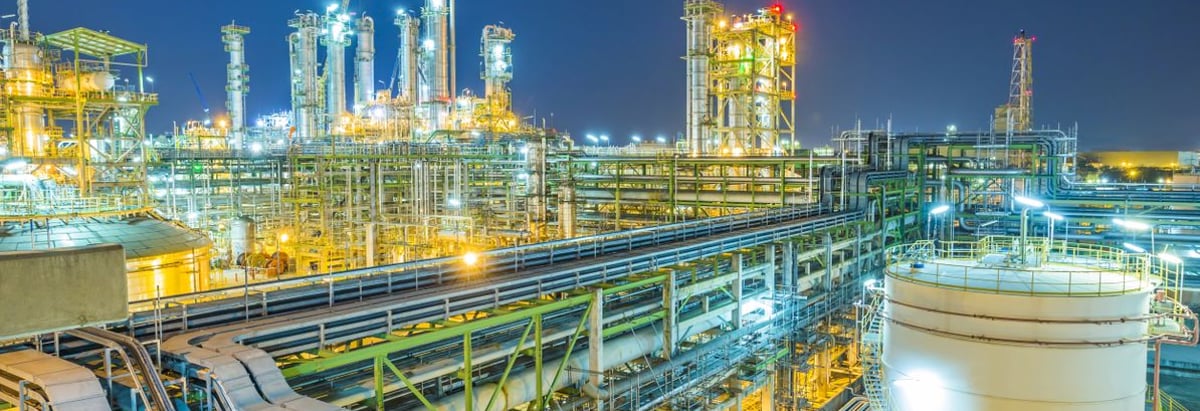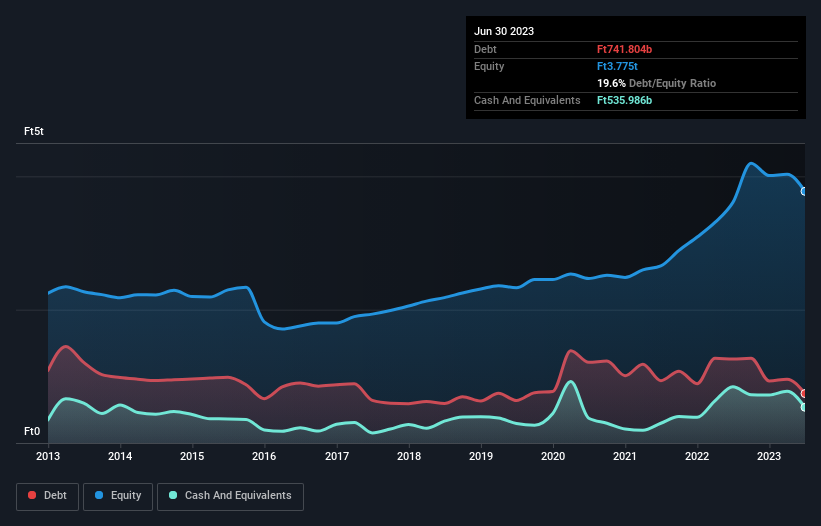- Hungary
- /
- Oil and Gas
- /
- BUSE:MOL
MOL Magyar Olaj- és Gázipari Nyilvánosan Muködo Részvénytársaság (BUSE:MOL) Takes On Some Risk With Its Use Of Debt

The external fund manager backed by Berkshire Hathaway's Charlie Munger, Li Lu, makes no bones about it when he says 'The biggest investment risk is not the volatility of prices, but whether you will suffer a permanent loss of capital.' When we think about how risky a company is, we always like to look at its use of debt, since debt overload can lead to ruin. As with many other companies MOL Magyar Olaj- és Gázipari Nyilvánosan Muködo Részvénytársaság (BUSE:MOL) makes use of debt. But the real question is whether this debt is making the company risky.
When Is Debt Dangerous?
Debt is a tool to help businesses grow, but if a business is incapable of paying off its lenders, then it exists at their mercy. Part and parcel of capitalism is the process of 'creative destruction' where failed businesses are mercilessly liquidated by their bankers. However, a more common (but still painful) scenario is that it has to raise new equity capital at a low price, thus permanently diluting shareholders. Of course, debt can be an important tool in businesses, particularly capital heavy businesses. The first step when considering a company's debt levels is to consider its cash and debt together.
View our latest analysis for MOL Magyar Olaj- és Gázipari Nyilvánosan Muködo Részvénytársaság
What Is MOL Magyar Olaj- és Gázipari Nyilvánosan Muködo Részvénytársaság's Net Debt?
You can click the graphic below for the historical numbers, but it shows that MOL Magyar Olaj- és Gázipari Nyilvánosan Muködo Részvénytársaság had Ft741.8b of debt in June 2023, down from Ft1.26t, one year before. On the flip side, it has Ft536.0b in cash leading to net debt of about Ft205.8b.

How Strong Is MOL Magyar Olaj- és Gázipari Nyilvánosan Muködo Részvénytársaság's Balance Sheet?
According to the last reported balance sheet, MOL Magyar Olaj- és Gázipari Nyilvánosan Muködo Részvénytársaság had liabilities of Ft1.98t due within 12 months, and liabilities of Ft1.59t due beyond 12 months. Offsetting these obligations, it had cash of Ft536.0b as well as receivables valued at Ft887.1b due within 12 months. So its liabilities outweigh the sum of its cash and (near-term) receivables by Ft2.14t.
When you consider that this deficiency exceeds the company's Ft1.85t market capitalization, you might well be inclined to review the balance sheet intently. Hypothetically, extremely heavy dilution would be required if the company were forced to pay down its liabilities by raising capital at the current share price.
We use two main ratios to inform us about debt levels relative to earnings. The first is net debt divided by earnings before interest, tax, depreciation, and amortization (EBITDA), while the second is how many times its earnings before interest and tax (EBIT) covers its interest expense (or its interest cover, for short). The advantage of this approach is that we take into account both the absolute quantum of debt (with net debt to EBITDA) and the actual interest expenses associated with that debt (with its interest cover ratio).
MOL Magyar Olaj- és Gázipari Nyilvánosan Muködo Részvénytársaság has a low debt to EBITDA ratio of only 0.15. And remarkably, despite having net debt, it actually received more in interest over the last twelve months than it had to pay. So it's fair to say it can handle debt like a hotshot teppanyaki chef handles cooking. But the other side of the story is that MOL Magyar Olaj- és Gázipari Nyilvánosan Muködo Részvénytársaság saw its EBIT decline by 6.8% over the last year. That sort of decline, if sustained, will obviously make debt harder to handle. When analysing debt levels, the balance sheet is the obvious place to start. But ultimately the future profitability of the business will decide if MOL Magyar Olaj- és Gázipari Nyilvánosan Muködo Részvénytársaság can strengthen its balance sheet over time. So if you want to see what the professionals think, you might find this free report on analyst profit forecasts to be interesting.
Finally, a company can only pay off debt with cold hard cash, not accounting profits. So the logical step is to look at the proportion of that EBIT that is matched by actual free cash flow. During the last three years, MOL Magyar Olaj- és Gázipari Nyilvánosan Muködo Részvénytársaság produced sturdy free cash flow equating to 66% of its EBIT, about what we'd expect. This free cash flow puts the company in a good position to pay down debt, when appropriate.
Our View
While MOL Magyar Olaj- és Gázipari Nyilvánosan Muködo Részvénytársaság's level of total liabilities has us nervous. To wit both its interest cover and net debt to EBITDA were encouraging signs. We think that MOL Magyar Olaj- és Gázipari Nyilvánosan Muködo Részvénytársaság's debt does make it a bit risky, after considering the aforementioned data points together. That's not necessarily a bad thing, since leverage can boost returns on equity, but it is something to be aware of. The balance sheet is clearly the area to focus on when you are analysing debt. However, not all investment risk resides within the balance sheet - far from it. For example MOL Magyar Olaj- és Gázipari Nyilvánosan Muködo Részvénytársaság has 3 warning signs (and 1 which can't be ignored) we think you should know about.
When all is said and done, sometimes its easier to focus on companies that don't even need debt. Readers can access a list of growth stocks with zero net debt 100% free, right now.
New: Manage All Your Stock Portfolios in One Place
We've created the ultimate portfolio companion for stock investors, and it's free.
• Connect an unlimited number of Portfolios and see your total in one currency
• Be alerted to new Warning Signs or Risks via email or mobile
• Track the Fair Value of your stocks
Have feedback on this article? Concerned about the content? Get in touch with us directly. Alternatively, email editorial-team (at) simplywallst.com.
This article by Simply Wall St is general in nature. We provide commentary based on historical data and analyst forecasts only using an unbiased methodology and our articles are not intended to be financial advice. It does not constitute a recommendation to buy or sell any stock, and does not take account of your objectives, or your financial situation. We aim to bring you long-term focused analysis driven by fundamental data. Note that our analysis may not factor in the latest price-sensitive company announcements or qualitative material. Simply Wall St has no position in any stocks mentioned.
About BUSE:MOL
MOL Magyar Olaj- és Gázipari Nyilvánosan Muködo Részvénytársaság
Operates as an integrated oil and gas company in Hungary and internationally.
Flawless balance sheet established dividend payer.


